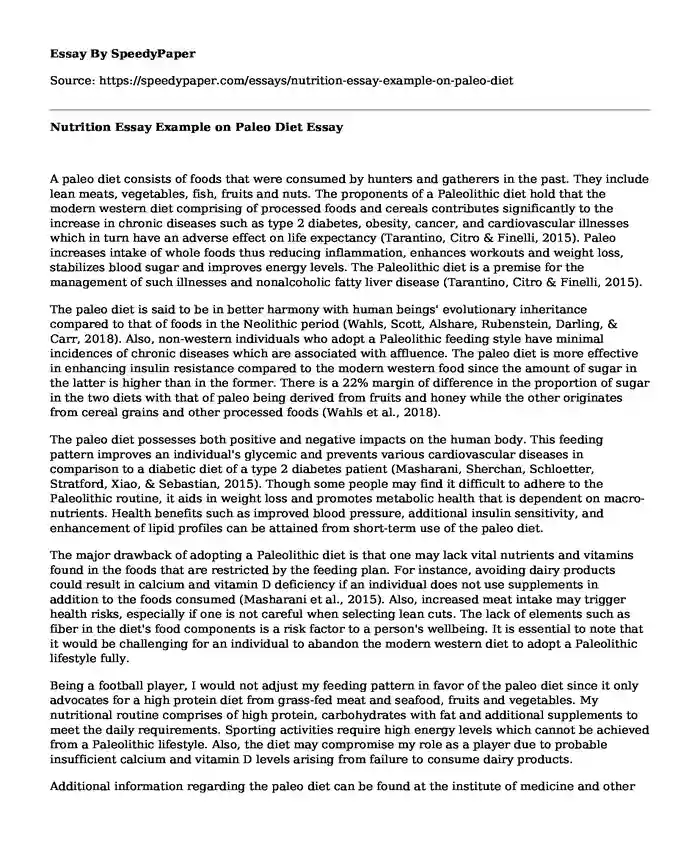A paleo diet consists of foods that were consumed by hunters and gatherers in the past. They include lean meats, vegetables, fish, fruits and nuts. The proponents of a Paleolithic diet hold that the modern western diet comprising of processed foods and cereals contributes significantly to the increase in chronic diseases such as type 2 diabetes, obesity, cancer, and cardiovascular illnesses which in turn have an adverse effect on life expectancy (Tarantino, Citro & Finelli, 2015). Paleo increases intake of whole foods thus reducing inflammation, enhances workouts and weight loss, stabilizes blood sugar and improves energy levels. The Paleolithic diet is a premise for the management of such illnesses and nonalcoholic fatty liver disease (Tarantino, Citro & Finelli, 2015).
The paleo diet is said to be in better harmony with human beings' evolutionary inheritance compared to that of foods in the Neolithic period (Wahls, Scott, Alshare, Rubenstein, Darling, & Carr, 2018). Also, non-western individuals who adopt a Paleolithic feeding style have minimal incidences of chronic diseases which are associated with affluence. The paleo diet is more effective in enhancing insulin resistance compared to the modern western food since the amount of sugar in the latter is higher than in the former. There is a 22% margin of difference in the proportion of sugar in the two diets with that of paleo being derived from fruits and honey while the other originates from cereal grains and other processed foods (Wahls et al., 2018).
The paleo diet possesses both positive and negative impacts on the human body. This feeding pattern improves an individual's glycemic and prevents various cardiovascular diseases in comparison to a diabetic diet of a type 2 diabetes patient (Masharani, Sherchan, Schloetter, Stratford, Xiao, & Sebastian, 2015). Though some people may find it difficult to adhere to the Paleolithic routine, it aids in weight loss and promotes metabolic health that is dependent on macro-nutrients. Health benefits such as improved blood pressure, additional insulin sensitivity, and enhancement of lipid profiles can be attained from short-term use of the paleo diet.
The major drawback of adopting a Paleolithic diet is that one may lack vital nutrients and vitamins found in the foods that are restricted by the feeding plan. For instance, avoiding dairy products could result in calcium and vitamin D deficiency if an individual does not use supplements in addition to the foods consumed (Masharani et al., 2015). Also, increased meat intake may trigger health risks, especially if one is not careful when selecting lean cuts. The lack of elements such as fiber in the diet's food components is a risk factor to a person's wellbeing. It is essential to note that it would be challenging for an individual to abandon the modern western diet to adopt a Paleolithic lifestyle fully.
Being a football player, I would not adjust my feeding pattern in favor of the paleo diet since it only advocates for a high protein diet from grass-fed meat and seafood, fruits and vegetables. My nutritional routine comprises of high protein, carbohydrates with fat and additional supplements to meet the daily requirements. Sporting activities require high energy levels which cannot be achieved from a Paleolithic lifestyle. Also, the diet may compromise my role as a player due to probable insufficient calcium and vitamin D levels arising from failure to consume dairy products.
Additional information regarding the paleo diet can be found at the institute of medicine and other scientific research-based articles that discuss the feeding pattern in detail.
Discussion Questions
What is your take on the paleo diet?
How does your current consumption routine relate to the Paleolithic lifestyle?
Explain your opinion regarding the benefits of a paleo diet while considering the potential lack of vital nutrients in the foods recommended for the routine. Do you think it is worth adopting?
References
Masharani, U., Sherchan, P., Schloetter, M., Stratford, S., Xiao, A., & Sebastian, A. (2015). Metabolic and physiologic effects from consuming a hunter-gatherer (Paleolithic)-type diet in type 2 diabetes. European Journal of Clinical Nutrition, 69(8), 944-948. doi: 10.1038/ejcn.2015.39
Tarantino, G., Citro, V., & Finelli, C. (2015). Hype or reality: should patients with metabolic syndrome-related NAFLD be on the Hunter-Gatherer (Paleo) diet to decrease morbidity? Journal Of Gastrointestinal And Liver Diseases, 24(3), 359-365. doi: 10.15403/jgld.2014.1121.243.gta
Wahls, T., Scott, M., Alshare, Z., Rubenstein, L., Darling, W., & Carr, L. (2018). Dietary approaches to treat MS-related fatigue: comparing the modified Paleolithic (Wahls Elimination) and low saturated fat (Swank) diets on perceived fatigue in persons with relapsing-remitting multiple sclerosis: study protocol for a randomized controlled trial. Trials, 19(1). doi: 10.1186/s13063-018-2680-x
Cite this page
Nutrition Essay Example on Paleo Diet. (2022, Aug 19). Retrieved from https://speedypaper.net/essays/nutrition-essay-example-on-paleo-diet
Request Removal
If you are the original author of this essay and no longer wish to have it published on the SpeedyPaper website, please click below to request its removal:
- Free Essay Sample about Traveling
- Enforcing Mental Health Parity: Essay Example with a Journal Article Critique
- Free Essay on Health Issues Among Critical Care Nurses
- Free Essay in History: Origins of Uprising in Yemen
- Essay Sample for Students: Blacks Representation in Media
- When One Has Lived a Long Time Alone - Poetry Analysis Essay Sample
- Free Essay. Gambling Increases the City's Revenue Although It Should Not Get Encouraged
Popular categories





